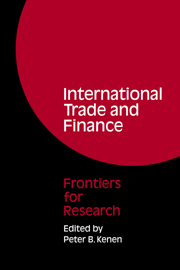Book contents
- Frontmatter
- Contents
- List of Contributors
- Preface
- PART I TRADE, PROTECTION, AND DOMESTIC PRODUCTION
- PART II ECONOMETRIC MODELS OF TRADE AND PAYMENTS
- Part III PAYMENTS ADJUSTMENT AND THE MONETARY SYSTEM
- Adjustment under Fixed and Flexible Exchange Rates
- International Reserves and Liquidity
- The LINK Model of World Trade, with Applications to 1972–73
- Discussion
- PART IV AN OVERVIEW AND AGENDA
- Glossary of Frequently Used Acronyms
- Author Index
Adjustment under Fixed and Flexible Exchange Rates
Published online by Cambridge University Press: 05 November 2011
- Frontmatter
- Contents
- List of Contributors
- Preface
- PART I TRADE, PROTECTION, AND DOMESTIC PRODUCTION
- PART II ECONOMETRIC MODELS OF TRADE AND PAYMENTS
- Part III PAYMENTS ADJUSTMENT AND THE MONETARY SYSTEM
- Adjustment under Fixed and Flexible Exchange Rates
- International Reserves and Liquidity
- The LINK Model of World Trade, with Applications to 1972–73
- Discussion
- PART IV AN OVERVIEW AND AGENDA
- Glossary of Frequently Used Acronyms
- Author Index
Summary
The topic of international adjustment under alternative exchange-rate systems can be defined broadly enough to cover almost all of international economics. In my efforts to narrow the topic to manageable proportions, I shall intentionally run the risk of ignoring important issues in order to make more specific comments about existing empirical work and some potential lines for future research.
I shall interpret “adjustment” broadly to refer to the whole range of changes in expenditures, employment, prices, savings, interest rates, exchange rates, and so on, that follow any exogenous change in the balance of payments. The simple fact underlying our interest in the subject is that national policy makers are always looking for easier ways to meet domestic employment and output goals, subject to some constraints, including that of a viable balance of payments. From their point of view, the purpose of learning more about the empirical facts of alternative exchange rate systems is to choose the one that makes their job easier. From a broader point of view, we must assess the congruence of the balance-of-payments targets chosen by national policy makers and consider the processes that come into play when the goals do not mesh. In this paper, I start somewhat farther back and concentrate on the empirical evidence describing various adjustment processes under fixed and flexible exchange rates. No policy conclusions of importance are reached, for the question of how to identify a better adjustment process when you see one is raised only at the end of the paper and is not answered.
- Type
- Chapter
- Information
- International Trade and FinanceFrontiers for Research, pp. 379 - 410Publisher: Cambridge University PressPrint publication year: 1976



